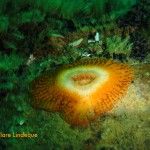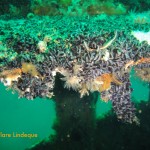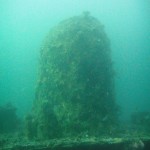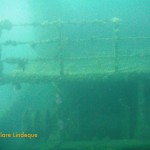
Tony has been alternately ragging and begging Grant for the last long while, wanting to dive the MV Aster in Hout Bay. He finally got his wish, along with me, Goot and Cecil, one magnificent weekend in early July. The sea was flat, the air was warm, and after an unseasonal week of southeasterly winds, the Atlantic was fairly clean.

The Aster is just outside Hout Bay harbour, fairly sheltered in the mouth of the bay. It was deliberately scuttled – by divers, for divers – in 1997. The ship was cleaned, the interior was stripped of wires and furnishings, and all doors and hatches were removed. Openings were cut into the hull of the ship, and it’s probably one of the most friendly wrecks to penetrate in Cape Town. When we dived it, Peter Southwood was venturing inside to check that his schemes of arrangement on the wikivoyage site are correct and current.

The top of the wreck is at a depth of about 20 metres, and if you bury yourself in the sand under the ship you might get 28 metres or so. There’s a large tripod mast that extends to within 10-12 metres of the surface, and ascending next to this is a treat. The ship stands upright, alone on a sandy bottom, and the wreck of the Katsu Maru lies about 30 metres away over the sand. The Aster was a crayfishing vessel, and is about 36 metres long. There are gangways, ladders, winches, lots of superstructure, and even a railing at the bow if you want to play Titanic there (Tony did).

The Atlantic is nutrient-rich (effluent from the Disa River in Hout Bay probably also helps here) and the wreck is quite heavily encrusted. Tony observed that even though the Cedar Pride, a wreck he dived when living in Jordan, has been underwater longer than the Aster, she’s far less covered with marine life.

I found a hagfish sleeping on deck below the mast, and we were delighted by the many tiny West coast rock lobsters all over the wreck (some large ones too). We found a couple the size of shrimps – adorable (to my mind)! There’s a lot of invertebrate life to enjoy, but I didn’t find any nudibranchs despite looking. Many of the ones found on this wreck are of the “beige with brown spots” variety and having never seen one in real life, it’s going to take a while to train my eyes to find them!

The marine life is lovely, and can absorb one for ages, but our chief enjoyment was in being on a large, intact wreck with lots of interesting shapes to look at. The tripod mast is spectacular, and there are winches, railings and cut-out compartments with windows that can all be enjoyed by a recreational diver not trained in wreck penetration. There are gangways along the side of the ship which are open on one side, and one or two areas on the deck that are overhead environments but have one whole wall missing, so a wreck penetration could be done in stages.
We dived on 32% nitrox, and I had a fifteen litre cylinder (sheer chance!). When we started ascending I still had 25 minutes of bottom time available, having spent the bulk of the dive at around 20 metres or so, and probably could have reached my NDL on the air remaining in my cylinder. Without buddies though – no thanks! Most of the dive we were accompanied by seals, and they were playing on the surface as we climbed back into the boat.

We’ve also done a night dive on this wreck – a spooky but thrilling experience.
Dive date: 10 July 2011
Air temperature: 23 degrees
Water temperature: 13 degrees
Maximum depth: 27.1 metres
Visibility: 12 metres
Dive duration: 37 minutes





































One thought on “Dive sites: MV Aster”
Comments are closed.